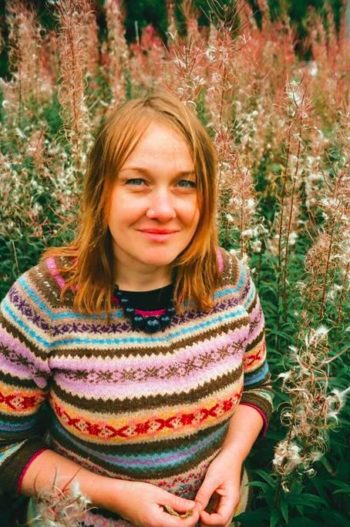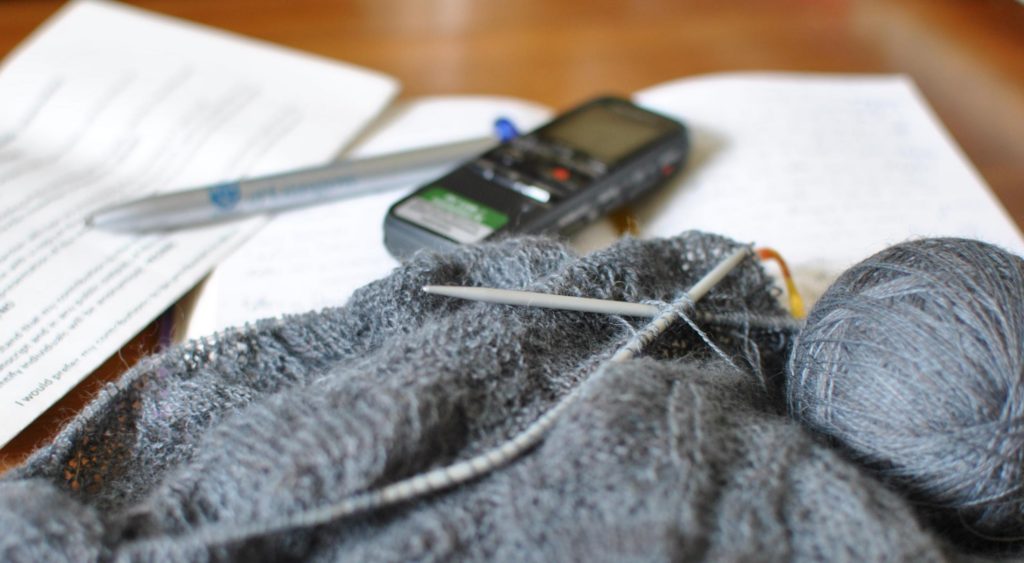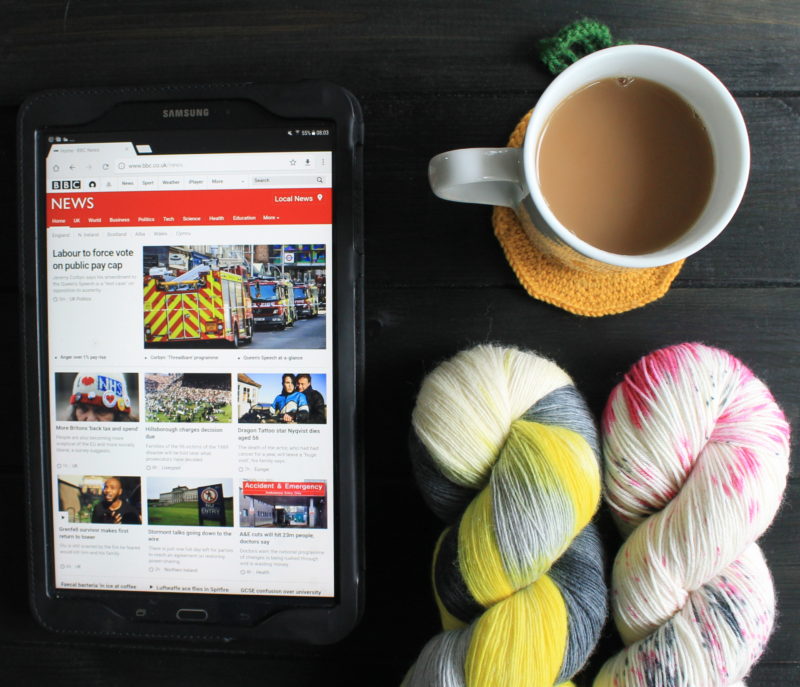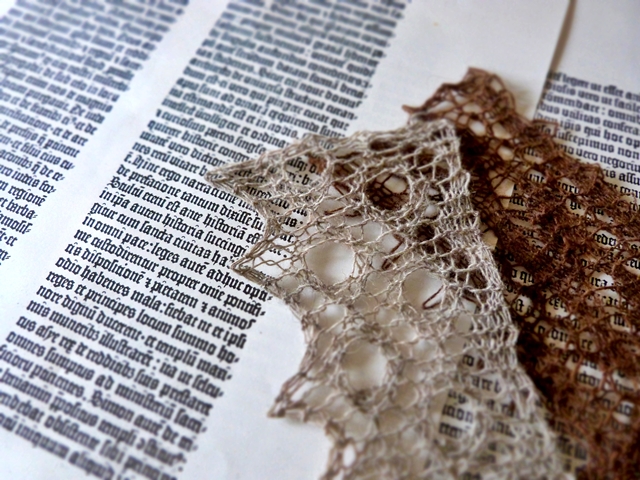Note from Karie: I am currently busy working on my book (the bulk of which is now with the graphic designer!), so I hope you'll enjoy this series of guest posts on creativity, making and identity penned by some very awesome people. You are in for a real treat as they explore our shared world of making. Today we are joined by Ellie Chalkley, an all-round music, media and culture enthusiast and citizen of the internet. She blogs and podcasts at listenoutside.com, a genre-agnostic stream of musical recommendations from Europe and beyond. I asked Ellie if she would write a guest post about crafting and fandom — I hope you'll enjoy!
-
I can’t remember a time before I loved Eurovision. The world’s biggest song contest has somehow always been a part of the rhythm of my year, even before I have any specific memories of the event itself. It comes after Easter, but before the school holidays, and it is a night for putting on your best and shiniest party frock, eating party rings and staying up late watching a slightly incomprehensible but undeniably entertaining feast of European pop music.
As an adult Eurovision fan, I still put the shiny party frocks on and eat the party rings, but one of the ways I express my enthusiasm is through crafting.
It started out innocuously enough making flag-iced cupcakes for the party I was hosting. I also made a small amigurumi effigy of Terry Wogan, the iconic UK commentator (Karie's note: the Terry amigurumi ended up featured on BBC). I don’t really know why I was doing this - I think there was a general shortage of specific Eurovision party accoutrements, and so if I wanted to go through with my theme, I had to do it myself.
I kept the Eurocrafting to cakes for a few years. An EU flag cake made with that blue food colouring implicated in childhood hyperactivity comes to mind, as does a beautiful rainbow cake hidden under chocolate icing and sugar pearls. As the years passed and the contest travelled the length and breadth of the continent, my knitting skills improved and my love for Eurovision deepened.
 Inevitably and happily, the two loves intermingled.
Inevitably and happily, the two loves intermingled.
In the wake of Loreen’s inspiring victory in Baku in 2012 I decided to knit a small doll of our new heroine. Maybe it was not the best depiction of her in terms of a likeness, but I was proud of the miniature diaphanous performance coat that I’d knitted from Habu paper yarn and the knitted-on construction of her halter top.
In 2016, a series of improbable coincidences lead to me planning a trip to Stockholm to attend and report on the contest for specialist news and analysis website ESC Insight. The fact that I would actually be attending Eurovision for the first time definitely needed to be marked with some form of crafting, and so the little doll idea came out again. I had great fun making poseable dolls of Iceland’s Greta Salome, Spain’s Barei and Australia’s Dami Im, who were three of my pre-contest favourites. I also wanted to celebrate all the countries taking part, so I dug into my scrap yarn bag and began knitting small hearts patterned with the 42 flags of the Eurovision countries.
Naturally, I didn’t quite get to all 42. The Union Jack presented the usual design complexity issues and the stranded colourwork of the various Nordic crosses resulted in some slow and careful knits that eventually blocked out beautifully. But I knew I was onto something, as the completed knitted flag hearts drew huge curiosity in the slightly boy-heavy and technological press room. I found that people were wanting to take the little hearts away and wear them into the arena to support their favourite countries.

One gorgeous Eurovision morning in Stockholm, I bought some beautiful BC Garn in a cotton wool blend. I picked a sunny sky mid blue and a rich wheaty yellow - the colours of the Swedish flag, and the colours of the 2016 winner, Ukraine. My summer knitting project was to design a shawl commemorating the trip to Stockholm that I could potentially wear in Kyiv the following year. I ended up doing a lot more than that.
My crafting for the 2017 Eurovision season largely took place during the National Final season running from late December to March — also known as the period when the intense and totally hardcore fans watch the hundreds of shortlisted songs around the continent being whittled down by various semi-democratic and random processes. I made tote bags and t-shirt transfers celebrating the winners of the contest; I made a sampler of my favourite Estonian song lyrics; I customised a silver jacket into an intricate homage to the excellent graphic design of the contest logo; and I sewed a full set of delicate felt lapel badges featuring the flags of 44 Eurovision (and future Eurovision) nations. I still wasn’t sure why I was doing any of this - it was all driven by enthusiasm and the desire not to let any creative idea pass me by.
 The felt flag badges proved to be an incredibly popular accessory for jazzing up people’s accreditation lanyards, and a unique way of making friends and staying memorable. My flag badges found their way into the Green Room on the lanyards of the Italian delegation, including the singer Francesco Gabbani, and into the BBC radio commentary booth with legendary UK broadcaster Ken Bruce. Once I started running out of flags for popular countries I set myself up in the press room with precut pieces so I could sew them for people on request, while we talked about our favourite songs and our hopes for the Grand Final. The handmade, unofficial nature of my flag badges made them special to me and hopefully to the recipients - a memory of a special time.
The felt flag badges proved to be an incredibly popular accessory for jazzing up people’s accreditation lanyards, and a unique way of making friends and staying memorable. My flag badges found their way into the Green Room on the lanyards of the Italian delegation, including the singer Francesco Gabbani, and into the BBC radio commentary booth with legendary UK broadcaster Ken Bruce. Once I started running out of flags for popular countries I set myself up in the press room with precut pieces so I could sew them for people on request, while we talked about our favourite songs and our hopes for the Grand Final. The handmade, unofficial nature of my flag badges made them special to me and hopefully to the recipients - a memory of a special time.
And into the future? I can feel some more ambitious Eurovision projects brewing as we prepare for the 2018 contest in Portugal, including hundreds more felt flag badges. Maybe I’ll embroider a scoreboard. Maybe I’ll do a stumpwork cushion of the stage design. Maybe I’ll sew my own silk tuxedo jacket and hand-embroider it with the national flowers of all competing nations?
Now, there’s an idea.
I’d better get started.
Eurovision is coming.

 This week we are joined by Benjamin G. Wilson, a writer and performer living between Manchester and Cornwall.
This week we are joined by Benjamin G. Wilson, a writer and performer living between Manchester and Cornwall.  Even if I live till 90, even if this is as old as my body ever feels, I’ve done more than a third. There will come a point where there is more behind me than there is in front. It is a cliché, one that will annoy genuinely middle aged people, but I have hit 30, and now I am thinking about death. If these things bother me, if I want to do more, then why don’t I? If these things are important, why not make time?
Even if I live till 90, even if this is as old as my body ever feels, I’ve done more than a third. There will come a point where there is more behind me than there is in front. It is a cliché, one that will annoy genuinely middle aged people, but I have hit 30, and now I am thinking about death. If these things bother me, if I want to do more, then why don’t I? If these things are important, why not make time? Back when I was working on my
Back when I was working on my 




 Image 3 ©
Image 3 © 
